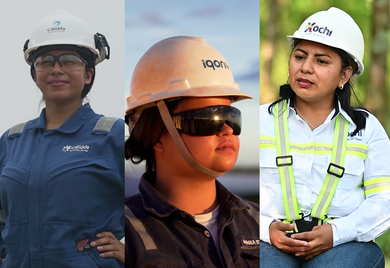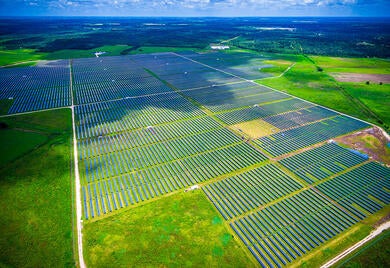
Energy and Transport Infrastructure: Projects Driving Jobs and Transforming Communities
IDB Invest works to boost job creation through the private sector and ensure these opportunities reach areas with the potential to develop new productive sectors and generate formal employment. Financing energy and transport infrastructure projects in Latin America and the Caribbean has been crucial for creating quality jobs and increasing women's workforce participation.

Overcoming Three Challenges to Unlock the Potential of Green Hydrogen
Several countries in Latin America and the Caribbean have an adequate renewable energy generation capacity, abundant water resources and other favorable conditions to diversify the power generation matrices and decarbonize energy-intensive industrial segments. Breaking down legal, regulatory, financial, technical and market barriers can help them lead the charge on clean energy initiatives.

Mobilizing Private Capital for Sustainable Infrastructure
Climate-related investments needed in the region through the end of the decade stand at between $470 billion and $1.3 trillion. Governments are unable to fund such amounts, so they are increasingly turning to the private sector to raise capital and relieve the pressure.

Towards a Fair, Inclusive Transition: Employing Women in Infrastructure Projects
Investments in infrastructure are key to an inclusive and job-creating recovery, and promote access to more and better services for lower-income households. But women are still little involved in this kind of projects.

Four countries leading in solar in Latin America and the Caribbean
Nearly half of the global electric power capacity could come from solar energy by 2025, according to McKinsey & Company. Multiple Latin American and Caribbean countries, benefitting from exceptional resources and evolved regulatory frameworks, have seen rapid growth in solar energy in the last few years. Utility scale projects are now considered commercially viable and receive private financing, while the application of distributed solar is growing quickly. However, falling solar prices are squeezing the industry, and macroeconomic uncertainty will continue to test its strength. Meanwhile, developers are now consolidating to gain market share and achieve profitability.

What powers Chile's energy transformation?
Recently The New York Times highlighted Chile’s energy transformation. The profile told the story of Chile’s clean energy market revolution. However, missing from the story was one key component that facilitated Chile’s sustainable energy surge: donor funds. Donor funds supported by governments can lower cost and risk barriers, which limit financing for renewable energy projects. Donor funds invest in untested technologies and new markets, while also adhering to the highest social and environmental standards. Their purpose is to jumpstart climate-friendly investments in developing countries. In 2008, Chile had less than 20 megawatts (MW) of installed non-conventional renewable energy (NCRE), such as wind, solar and geothermal. The government’s Energy 2050 law set a target to increase Chile’s share of renewable energy to at least 60% by 2035. Despite developers’ enthusiasm for Chile’s stable political environment and resource endowment, which includes over 300 days of sunshine per year in the Atacama Desert, local banks had little or no experience with NCRE technologies. Donor funds: able to overcome cost and risk barriers But with access to donor funds, other organisms, such as multilaterals can deploy financial structures that overcome certain cost and risk barriers, making projects feasible for developers. Funds like the Clean Technology Fund (CTF) and the Canadian Climate Fund for the Private Sector in the Americas (C2F) allow us to “blend” our capital and ultimately take more risks. For example, in 2013, IDB Invest (formerly known as Inter-American Investment Corporation) used a C2F loan plus our own financing for Pozo Almonte and Calama Solar, Latin America’s first large-scale photovoltaic plants. The Chilean market evolved rapidly. By 2014, the Crucero solar project, which IDB Invest also financed, piqued the interest of a commercial bank. Soon commercial banks fully financed hundreds of megawatts of NCRE. Today, solar photovoltaic in Chile no longer needs donor money. Thanks in large part to donor funds, IDB Invest financed five photovoltaic projects in Chile and recently completed our first wind project, contributing to Chile’s 3,400 MW of NCRE. A recent Inspiratia article, which covered the Aela wind farm, recognized, “for Aela, the [IDB Invest] involvement was key, not only from a ticket size perspective, but also in helping the commercial banks get comfortable with the transaction. In the Cerro Pabellon geothermal plant, by channeling resources from the CTF, for which IDB Invest is the implementing entity, IDB Invest provided an insurance-like financial instrument to Enel Green Power to offset the high cost and risk associated with exploratory geothermal drilling — a risk most commercial lenders and insurance providers are typically unwilling to take. Development banks are one of the few players positioned to test first-mover risks and provide long-term tenors; however, it is the donor funds that are perhaps the unsung heroes of Chile’s energy transformation. Market forces taking over where donor funds left off is a trend that transcends Chile. Uruguay, Costa Rica and now El Salvador have all contributed to Latin America’s renewable surge which is 53% of total energy generation compared to the 22% world average. Back in Chile, the lure of cleaner, commercially-viable energy is now attracting the next generation of industry. Companies like Amazon and Alphabet Inc.’s Google would like to set up data centers powered by this renewable energy. These firms create jobs and offer training to the Chilean workforce. And so the renewable energy story continues. Subscribe to receive more content like this! [mc4wp_form]